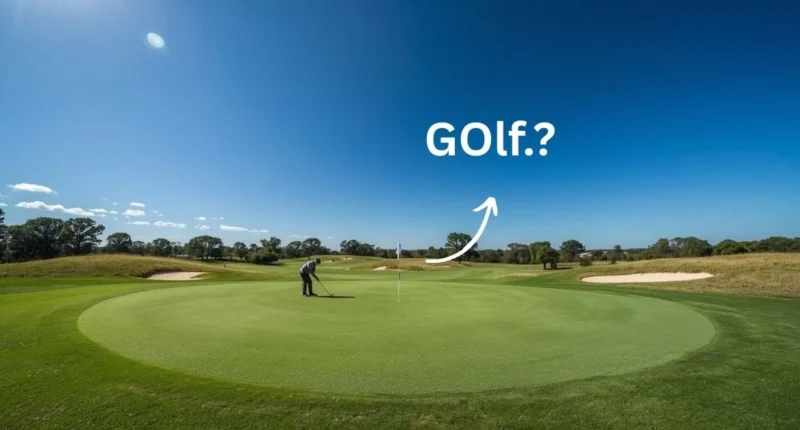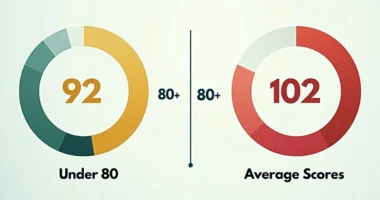Golf is one of the world’s oldest and most popular sports, played in over 200 countries and loved by millions of people. At first glance, it may seem simple: hit a ball into a hole using as few strokes as possible. But behind that simplicity lies a game filled with tradition, strategy, patience, and skill.
Unlike most sports, golf doesn’t require a stadium, goalpost, or even opponents standing in your way. Instead, the challenge comes from the golf course itself—rolling greens, bunkers filled with sand, lakes, trees, and weather conditions all test a player’s ability.
What is Golf?
At its core, golf is a precision sport where players use clubs to hit a small ball into a series of holes on a course. The objective is simple: complete the course using the fewest possible strokes.
Most courses have 18 holes, though smaller courses may have 9. Each hole has a starting point (the tee box), a fairway, hazards, and a green where the hole and flagstick are located.
The beauty of golf lies in the fact that it is both an individual and a social game. You can play alone against the course or with friends in a group, making it both competitive and recreational.
A Brief History of Golf
- Origins in Scotland: Modern golf originated in 15th-century Scotland, where shepherds used sticks to hit stones into rabbit holes. By the 1500s, it had become popular enough that King James II briefly banned it because soldiers were spending more time golfing than training for war.
- The Old Course at St Andrews: Often called the “Home of Golf,” St Andrews Links in Scotland is one of the oldest courses in the world and remains iconic today.
- Global Expansion: The game spread to England, then to the United States in the late 1800s. By the 20th century, it had become an international sport.
- Modern Golf: Today, professional tours like the PGA Tour (US) and DP World Tour (Europe) attract millions of fans, while events such as the Masters, The Open Championship, and Ryder Cup are among the biggest in the sporting world.
The Objective of Golf
The aim of golf is straightforward: hit the ball from the tee into the hole in as few shots as possible.
Par: Each hole has a “par,” which is the number of strokes an expert golfer is expected to take. Holes are usually par 3, par 4, or par 5.
Scoring Terms:
- Birdie: One stroke under par.
- Eagle: Two strokes under par.
- Bogey: One stroke over par.
- Double Bogey: Two strokes over par.
- Hole-in-One: Getting the ball into the hole in a single shot from the tee.
Basic Rules of Golf
Golf has many rules, governed by the R&A and USGA, but here are the most important ones:
- Play the Ball Where It Lies: You generally can’t move the ball to a better position.
- Teeing Off: Each hole begins on the tee box.
- Fairway and Rough: Stay on the fairway if possible; rough areas are harder to play from.
- Hazards: Sand bunkers and water hazards add challenge. Players must take penalty strokes if the ball lands in water.
- Putting Green: Once on the green, players use a putter to roll the ball into the hole.
- Order of Play: The player farthest from the hole plays first.
- Etiquette: Players must respect others, stay quiet during swings, and care for the course (repairing divots, raking bunkers).
The Golf Course
A standard golf course has 18 holes, but each hole is different. Let’s break down the key parts:
- Tee Box: Where each hole begins.
- Fairway: The short grass area between the tee and the green.
- Rough: Taller grass surrounding the fairway, harder to play from.
- Bunkers: Sand traps that test a golfer’s skill.
- Water Hazards: Lakes, rivers, or ponds that add risk.
- Green: Smooth, short grass area with the hole and flagstick
Golf Equipment
Golf requires specific equipment, including:
Golf Clubs
- Driver: For long-distance tee shots.
- Irons: For mid-range shots.
- Wedges: For short, precise shots and bunkers.
- Putter: For rolling the ball on the green.
- Players can carry up to 14 clubs in their bag.
- Golf Ball: Small, dimpled ball designed for distance and accuracy.
- Golf Tees: Small pegs that hold the ball for the first shot of each hole.
- Golf Bag: To carry clubs and accessories.
- Golf Shoes and Gloves: Provide stability and grip.
Different Formats of Golf
Golf can be played in various formats:
- Stroke Play: The most common total stroke count across all holes.
- Match Play: Players compete hole by hole.
- Stableford: Points system based on performance against par.
- Scramble: A fun team format often used in charity events.
Why Do People Love Golf?
- Relaxing & Social: Golf is played in beautiful outdoor settings, making it both calming and social.
- All Ages: Unlike many sports, golf can be played from childhood into old age.
- Challenge: The course, not opponents, is often the biggest rival.
- Exercise: Walking 18 holes can cover 4–6 miles, a great workout.
Famous Golf Tournaments
Some of the most prestigious golf events include:
- The Masters (USA)
- The Open Championship (UK)
- The Ryder Cup (Europe vs USA)
- The PGA Championship
- The U.S. Open
These tournaments showcase the best players in the world and are watched by millions globally.
Modern Legends of Golf
Some of the greatest players who made golf iconic include:
- Tiger Woods – 15-time major champion, global superstar.
- Jack Nicklaus – Holds a record 18 major titles.
- Arnold Palmer – Popularized golf in the 20th century.
Rory McIlroy, Phil Mickelson, Brooks Koepka, and Jon Rahm – Modern stars who keep the game exciting.
Conclusion: Why Golf Stands the Test of Time
Golf is more than just a sport it’s a tradition, a challenge, and a lifestyle. Whether you play for fun, fitness, or competition, golf offers something unique: the chance to enjoy the outdoors, test your patience, and celebrate small victories.
From its Scottish origins to today’s global stage, golf has remained a sport that welcomes players of every age and skill level. And while it may take a lifetime to master, the joy of the game lies in the journey, not just the score.





